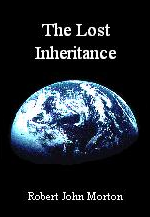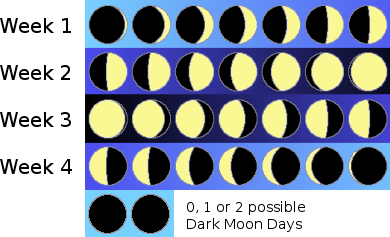
Ch03: Footnotes
The Lunar Cycle
Ancient Texts
Bible Anomalies
The Gospel
Tax & Tithing
Holy Spirit
Fuzzy Overview
Language Barrier
Life After Death
Human Destiny
Religon/Disclaimer
Salvation
Tick-Box Forms
Vida Após da Morte
If the lunar month were exactly 28 days, the lit fraction of the moon's disc would form a 7 day cycle. It would swap sides twice a month and the moon itself would move once from the evening sky to the morning sky and back again. This would make 4 different 'kinds' of week.
The lunar month is not, however, an exact number of days or weeks. It is currently about 29·530588853 days [29 days, 12 hours, 44 minutes, 2·8768992 seconds]. So, was it ever 28 days (4 weeks of 7 days) sometime in the past?
The Earth currently rotates at almost 30 times the rate at which the Moon revolves around it. Weak gravitational coupling, provided by the Earth's ocean tides, therefore continually saps rotational energy from the Earth to increase the Moon's energy of revolution.
This, in turn causes the Moon's orbital radius to increase (currently at about 38mm per year) and the synodic month to increase by about 0·00000073% per century. Hence, this month is a little bit longer than last month and next month will be a little bit longer than this month.
The Earth's rate of rotation is decelerating at 1·4 milliseconds per day per century or thereabouts. This means that the Earth's day is increasing each century by about 0·00000162%. Thus, today is always a little bit longer than yesterday and tomorrow will be a little bit longer than today.
However, comparing the two reveals that the length of the day is increasing at 2·213 times the rate at which the length of the month is increasing. This means that the number of days in the month is gradually decreasing. Consequently, the month could never have been exactly 28 days in the past. If at all, it can only become 28 days at some time in the far distant future.
This notwithstanding, it is unlikely that the number of days in a month has changed significantly while sentient humans have lived on this planet. I am no astronomer, so if you know the answer, please email me.
A sense of the 7-day week is apparent from the moon's phases throughout its monthly cycle. Looking at the moon's phases, you can clearly see 4 weeks. The pattern of the phase changes of the moon is different in each of the 4 weeks of the month as illustrated below.

During the 1st week of a lunar month, the lighted part grows from a new-moon to a half-moon. During the 2nd week, it grows from a half-moon to a full-moon. During the 3rd week, it diminishes from a full-moon to a half-moon. During the 4th week, it diminishes from a half-moon back to a new-moon, thus completing the cycle.
However, because in reality there is not exactly an integral number of 28 days (4 times 7 days) in a month, the first day of the first week of the next month does not always follow the last day of the last week of the previous month. There is sometimes a day when the moon cannot be seen at all. This is called a Dark Moon day (from which we probably get the name Monday which is now wrongly applied to one of the days of the week. A Dark Moon day is not part of any week. It is out on its own.
This at first seems to throw doubt on the idea that the 7 day week came from moon phases observed by the Ancients as some suggest. But that is only if we assume that weeks are concatenated blocks of 7 days — that is, if we assume that a week always begins with the day immediately following the last day of the previous week.
Some ancient lunar calendars used a 7 day week that allowed for 'frame slippage'. That is, when the week got more than a day out of synchrony with the moon's phases, you simply inserted an extra 'padding' day (or sometimes two days) at the end of a month to delay the start of the first week of the next month. I am given to understand that such a day was indeed referred to as a Dark Moon day because on such a day the moon would not be visible. The ancients recognized that a Dark Moon day was not a part of any week. It was separate.
![Where the Dark Moon days [Mondays] fit in. Illustration of the occurrence of Dark Moon days [Mondays].](images/darkmoon.png)
The 7 day week has been maintained through millennia as a unit of time of exactly 7 integral days. But a calendar of continuous concatenated integral 7 day weeks has no natural frame of reference with which its synchrony could be scientifically verified at any time in history or any place in the world. It is totally dependent on human counting or time-keeping by some central human authority or college. The human propensity for mistakes makes it very doubtful that this counting could have continued over thousands of years through all humanity's migrations, wars, social changes, religious upheavals and intellectual differences without error.
Some religious people think the lunar-week (where you pad out the month to maintain lunar synchrony) is correct. Others think the fixed-week (where you just keep on counting 1 through 7 then start immediately at 1 again) is correct. The main contention this causes among people of certain religions is that it effectively changes the day on which their respective Sabbaths or Holy Days fall.
The 7 annual holy days mentioned in the Judeao-Christian Bible form a fixed pattern of timing from the first holy day to the last holy day. However, this pattern is far from synchronized with the solar year. Its position within the solar year jitters from one year to the next. Or as engineers would say, it suffers 'frame slippage'. Hence these holy days shift slightly from year to year in terms of the solar or botanical seasons in which they fall. Furthermore, the number of days between the last holy day of one year and the first holy day of the next year can vary enormously. I am not aware that the observed asynchrony of the annual holy days within the solar year is anywhere disputed.
I speculate that the annual holy days were made asynchronous deliberately: firstly because they represent the phases of a once-only transient process, and secondly because the times between the phases are not pre-set, but depend on when certain predicted circumstances materialise within the complex dynamic of human society.
The 7-day week also is a repeated or cyclic reminder of a once-only or transient master plan. So as the annual holy days bear an asynchronous relationship to the annual cycle, so too would I expect the weekly holy day to bear an asynchronous relationship to the lunar cycle. And for the same reason — to ensure that we realise that the process we are being repeatedly reminded of is a once-only sequence of events rather than a recurring cycle.
The imperfect fit between the daily, lunar and annual cycles does not sit comfortably within the minds of mechanistic thinkers. The Romans seemed to have a problem with it. I think the 'clockwork universe' Victorians would have too. I did. That is, until a few years ago when I introduced myself to
chaos theory. Now I welcome the assynchrony between the earth, moon and sun. It writes for each of us a unique and inspiring melody upon the regular rhythm of life, making each day, month, season and year a unique and memorable piece of history.
For details on the moon's phases and how they vary from day to day, look at some of the following sites.